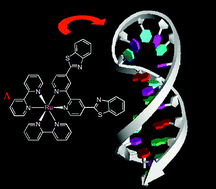Inert benzothiazole functionalised ruthenium(ii) complexes; potential DNA hairpin binding agents†
Abstract
The two enantiomers of [Ru(bpy)2(bbtb)]2+ {bpy = 2,2′-bipyridine; bbtb = 4,4′-bis(benzothiazol-2-yl)-2,2′-bipyridine} have been isolated and fully characterised. Both enantiomers have been shown to have a strong association with calf thymus DNA by UV/visible absorption, emission and CD spectroscopy, with the Λ enantiomer having the greater affinity. The binding of both enantiomeric forms of [Ru(bpy)2(Me2bpy)]2+ and [Ru(bpy)2(bbtb)]2+ {Me2bpy = 4,4′-dimethyl-2,2′-bipyridine} to a range of oligonucleotides, including an octadecanucleotide and an icosanucleotide which contain hairpin-sequences, have been studied using a fluorescent intercalator displacement (FID) assay. The complex [Ru(bpy)2(bbtb)]2+ exhibited an interesting association with hairpin oligonucleotides, again with the Λ enantiomer binding more strongly. A 1H NMR spectroscopic study of the binding of both enantiomers of [Ru(bpy)2(bbtb)]2+ to the icosanucleotide d(CACTGGTCTCTCTACCAGTG) was conducted. This sequence contains a seven-base-pair duplex stem and a six-base hairpin-loop. The investigation gave an indication of the relative binding of the complexes between the two different regions (duplex and secondary structure) of the oligonucleotide. The results suggest that both enantiomers bind at the hairpin, with the ruthenium centre located at the stem–loop interface. NOE studies indicate that one of the two benzothiazole substituents of the bbtb ligand projects into the loop-region. A simple model of the metal complex/oligonucleotide adduct was obtained by means of molecular modelling simulations. The results from this study suggest that benzothiazole complexes derived from inert polypyridine ruthenium(II) complexes could lead to the development of new fluorescent DNA hairpin binding agents.


 Please wait while we load your content...
Please wait while we load your content...